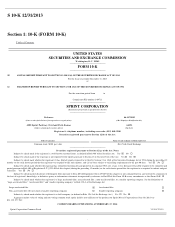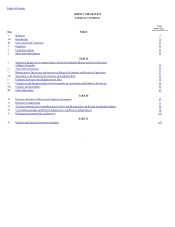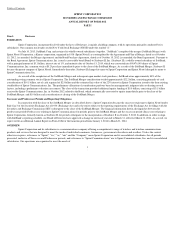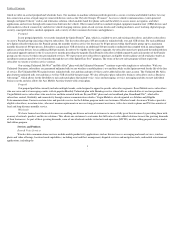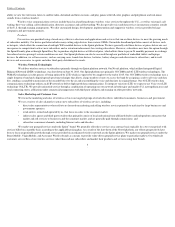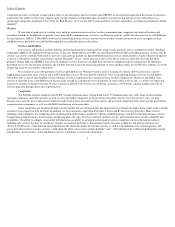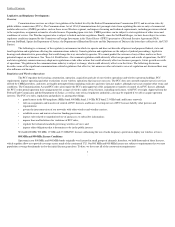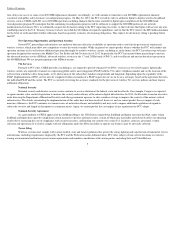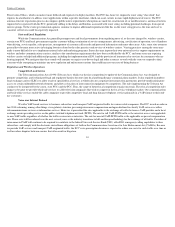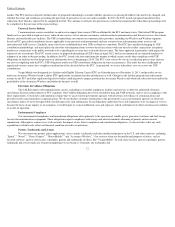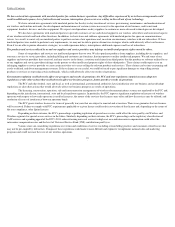Sprint - Nextel 2013 Annual Report Download - page 10
Download and view the complete annual report
Please find page 10 of the 2013 Sprint - Nextel annual report below. You can navigate through the pages in the report by either clicking on the pages listed below, or by using the keyword search tool below to find specific information within the annual report.
Table of Contents
applicable to these licenses, except in the case of licenses that are not material to our business. Our 800 MHz and 900 MHz licenses have ten
-
year terms, at the
end of which each license is subject to renewal requirements that are similar to those for our 1.9 GHz licenses described below.
1.9 GHz PCS License Conditions
All PCS licenses are granted for ten
-
year terms. For purposes of issuing PCS licenses, the FCC utilizes major trading areas (MTAs) and basic trading
areas (BTAs) with several BTAs making up each MTA. Each license is subject to build
-
out requirements, which we have met in all of our MTA and BTA
markets.
If applicable build
-
out conditions are met, these licenses may be renewed for additional ten
-
year terms. Renewal applications are not subject to
auctions. If a renewal application is challenged, the FCC grants a preference commonly referred to as a license renewal expectancy to the applicant if the
applicant can demonstrate that it has provided "substantial service" during the past license term and has substantially complied with applicable FCC rules and
policies and the Communications Act. The licenses for the 10 MHz of spectrum in the 1.9 GHz band that we received as part of the FCC's Report and Order,
described below, have ten
-
year terms and are not subject to specific build
-
out conditions, but are subject to renewal requirements that are similar to those for
our PCS licenses.
2.5 GHz License Conditions
We own or lease spectrum located within the 2496 to 2690 MHz band, commonly referred to as the 2.5 GHz band, which is designated for Broadband
Radio Services (BRS) and Educational Broadband Service (EBS). Most BRS and EBS licenses are allocated to specific geographic service areas. Other BRS
licenses provide for 493 separate BTAs. Under current FCC rules, the BRS and EBS band in each territory is generally divided into 33 channels consisting of a
total of 186 MHz of spectrum, with an additional eight MHz of guard band spectrum, which further protects against interference from other license holders.
Under current FCC rules, we can access BRS spectrum either through outright ownership of a BRS license issued by the FCC or through a leasing arrangement
with a BRS license holder. The FCC rules generally limit eligibility to hold EBS licenses to accredited educational institutions and certain governmental, religious
and nonprofit entities, but permit those license holders to lease up to 95% of their capacity for non
-
educational purposes. Therefore, we primarily access EBS
spectrum through long
-
term leasing arrangements with EBS license holders. Generally, EBS leases entered into before January 10, 2005 may remain in effect for
up to 15 years and may be renewed and assigned in accordance with the terms of those leases and the applicable FCC rules and regulations. The initial term of
EBS leases entered into after January 10, 2005 is required by FCC rules to be coterminous with the term of the license. Our EBS spectrum leases typically have an
initial term equal to the remaining term of the EBS license, with an option to renew the lease for additional terms, for a total lease term of up to 30 years. In
addition, we generally have a right of first refusal for a period of time after our leases expire or otherwise terminate to match another party's offer to lease the
same spectrum. Our leases are generally transferable, assuming we obtain required governmental approvals.
Spectrum Reconfiguration Obligations
In 2004, the FCC adopted a Report and Order that included new rules regarding interference in the 800 MHz band and a comprehensive plan to
reconfigure the 800 MHz band (the "Report and Order"). The Report and Order provides for the exchange of a portion of our 800 MHz FCC spectrum licenses,
and requires us to fund the cost incurred by public safety systems and other incumbent licensees to reconfigure the 800 MHz spectrum band. Also, in exchange,
we received licenses for 10 MHz of nationwide spectrum in the 1.9 GHz band.
The minimum cash obligation under the Report and Order is
$2.8 billion
. We are, however, obligated to pay the full amount of the costs relating to the
reconfiguration plan, even if those costs exceed
$2.8 billion
. As required under the terms of the Report and Order, a letter of credit has been secured to provide
assurance that funds will be available to pay the relocation costs of the incumbent users of the 800 MHz spectrum. Total payments directly attributable to our
performance under the Report and Order, from the inception of the program through
December 31, 2013
, were approximately
$3.3 billion
, of which primarily all
payments incurred during the year ended
December 31, 2013
related to FCC licenses. When incurred, substantially all costs are accounted for as additions to
FCC licenses with the remainder as property, plant and equipment. Although costs incurred through
December 31, 2013
have exceeded
$2.8 billion
, not all of
those costs have been reviewed and accepted as eligible by the transition administrator.
Completion of the 800 MHz band reconfiguration was initially required by June 26, 2008. The FCC continues to grant 800 MHz public safety licensees
additional time to complete their band reconfigurations which, in
8

